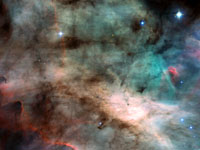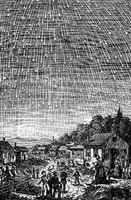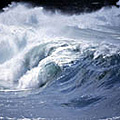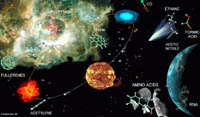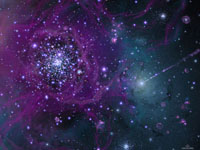The Big Bang
Most astronomers believe the Universe began in a Big Bang about 14 billion years ago. At that time, the entire Universe was inside a bubble that was thousands of times smaller than a pinhead. It was hotter and denser than anything we can imagine.
Then it suddenly exploded. The Universe that we know was born. Time, space and matter all began with the Big Bang. In a fraction of a second, the Universe grew from smaller than a single atom to bigger than a galaxy. And it kept on growing at a fantastic rate. It is still expanding today.
As the Universe expanded and cooled, energy changed into particles of matter and antimatter. These two opposite types of particles largely destroyed each other. But some matter survived. More stable particles called protons and neutrons started to form when the Universe was one second old.
Over the next three minutes, the temperature dropped below 1 billion degrees Celsius. It was now cool enough for the protons and neutrons to come together, forming hydrogen and helium nuclei.
After 300 000 years, the Universe had cooled to about 3000 degrees. Atomic nuclei could finally capture electrons to form atoms. The Universe filled with clouds of hydrogen and helium gas.
In the beginning
Living things breathe, feed, grow and leave offspring. They range from the simplest single-celled bacteria to plants, birds, animals and humans. Earth is the only world we know that supports life. No one knows how life began. It seems to involve the coming together of certain chemicals. But what changes these chemicals into life-forms is a mystery.
Studies of ancient rocks have shown that life began on Earth about 3 800 million years ago. At that time, the Earth was a very unfriendly place. The air was dense and poisonous. Comets and meteorites were raining down on the planet.
The young Earth was a water world with small areas of dry land. Many scientists think that life began in the lakes and oceans. Many of the ingredients from which life started may have been brought by comets and meteorites.
Did life begin in the oceans?
Lightning and ultraviolet light from the Sun may have split the hydrogen-rich gases in the atmosphere. Energy may also have come from hot springs on the sea bed, known as ‘black smokers’. Over time, the simple chemicals joined to become larger, more complex chemicals.
Once these chemicals collected in the oceans or lakes, they formed an 'organic soup'. One day, an accident occurred. A molecule began to make copies of itself. Earth had sprung to life.
Extreme life
Today, scientists are not so sure that life began on or near the Earth's surface. Everywhere we look, there seems to be life – even several kilometres underground. It may be that life began at the bottom of the oceans, where hot springs provided energy instead of sunlight.
Another idea is that life – or at least the chemical building blocks – came from space. Many comets were crashing into Earth early in its history. Comets are rich in carbon-based chemicals from which life could have started.
It is also possible that life could transfer from one planet to another. It seems that life is tough enough to survive a long journey through space. A large comet or meteorite crashing into the Earth could throw large numbers of rocks into space. Any bacteria that are riding as passengers on these rocks could eventually land on another planet.
In the same way, a meteorite from Mars could carry Martian life (if it existed) to Earth. In 1996, scientists told the world that they had found just such a Martian rock in Antarctica. However, other scientists question their research.
The birth of galaxies
We cannot see anything that happened during the first 300 000 years of the Universe. Scientists try to work it out from their knowledge of atomic particles and from computer models.
The only direct evidence of the Big Bang itself is a faint glow in space. Spacecraft and telescopes on balloons see this as a patchy pattern of slightly warmer and cooler gas all around us. These ripples also show where the hydrogen clouds were slightly denser.
As millions of years passed, the dense areas pulled in material because they had more gravity. Finally, about 100 million years after the Big Bang, the gas became hot and dense enough for the first stars to form.
New stars were being born at a rate 10 times higher than in the present-day Universe. Large clusters of stars soon became the first galaxies.
The Hubble Space Telescope and powerful ground-based telescopes are now beginning to find galaxies that were created about one billion years after the Big Bang. These small galaxies were much closer together than galaxies are today. Collisions were common. Like two flames moving towards each other, they merged into bigger galaxies. Our Milky Way galaxy came together in this way.
The birth of galaxies
We cannot see anything that happened during the first 300 000 years of the Universe. Scientists try to work it out from their knowledge of atomic particles and from computer models.
The only direct evidence of the Big Bang itself is a faint glow in space. Spacecraft and telescopes on balloons see this as a patchy pattern of slightly warmer and cooler gas all around us. These ripples also show where the hydrogen clouds were slightly denser.
As millions of years passed, the dense areas pulled in material because they had more gravity. Finally, about 100 million years after the Big Bang, the gas became hot and dense enough for the first stars to form.
New stars were being born at a rate 10 times higher than in the present-day Universe. Large clusters of stars soon became the first galaxies.
The Hubble Space Telescope and powerful ground-based telescopes are now beginning to find galaxies that were created about one billion years after the Big Bang. These small galaxies were much closer together than galaxies are today. Collisions were common. Like two flames moving towards each other, they merged into bigger galaxies. Our Milky Way galaxy came together in this way.
